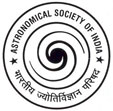June 2019:
The AstroSat Picture of the Month for June 2019 is the far-ultraviolet image of the Dwarf Galaxy IC2574, using ASTROSAT. The far-ultraviolet traces young massive stars in the galaxy.
(Picture Credits: Chayan Mondal and collaborators)


“AstroSat Picture of the Month” is an initiative of the Public Outreach and Education Committee of the Astronomical Society of India and the AstroSat Training and Outreach Team.
Star formation around bubbles in the Dwarf galaxy IC2574
In the APOM this month, we bring you the dwarf galaxy IC2574. As the name suggests, dwarf galaxies are smaller, fainter and less massive than galaxies such as the Milky Way or Andromeda. While dwarf galaxies host hundreds of millions to a few billion stars, the larger galaxies can have nearly hundred to thousand times more number of stars. It has been found that these small dwarf galaxies are more in number as compared to larger galaxies like Milky Way in the Universe.
IC2574 is also known as Coddington's nebula, after Edwin Foster Coddington who discovered it in 1898. It is located at a distance of approximately 12 million light years away and can be found in the Ursa Major constellation in the north. It is irregular in shape like the Wolf-Lundmark-Melotte (WLM) galaxy, presented in our very first APOM. IC2574 was imaged in ultraviolet by Chayan Mondal and collaborators using the Ultraviolet Imaging Telescope (UVIT) on-board AstroSat. They wanted to study the regions where young massive stars in this galaxy are located. Hot massive stars are those stars which weigh more than 10 times the mass of Sun and they emit significant fraction of their light in ultraviolet.
These researchers have identified sites of most massive stars in IC2574 using the ultraviolet images. They find that about one-third of them could have been formed as a result of previous supernova explosions. When massive stars die in supernova explosions, the outer layers are blown outwards into the surrounding gas, and form spherical shells. These expanding bubbles compress the gas between them which could initiate star formation in the rims of the bubble structures, leading to a new generation of stars. The authors suggest that in IC2574, one of the mechanisms to form young stars is gas compression following shell expansion. Unlike spiral galaxies like Milky Way, where stars are formed mostly in the spiral arms, it is possible that formation of later generations of stars in dwarf galaxies could be because of these bubble structures.
More details of this work can be found in their paper, which has been submitted to the Astrophysical Journal.
Click here for the entire APOM archive.
More about ASTROSAT
AstroSat, India's first dedicated multi-wavelength space observatory, was launched by ISRO on 28 September, 2015. It has five instruments on board – the Ultra Violet Imaging Telescope, the Soft X-ray Telescope, the Large Area X-ray Proportional Counter, the Cadmium-Zinc-Telluride Imager and the Scanning Sky Monitor.
Get answers to your common queries about ASTROSAT in English, in हिंदी, and in मराठी.

